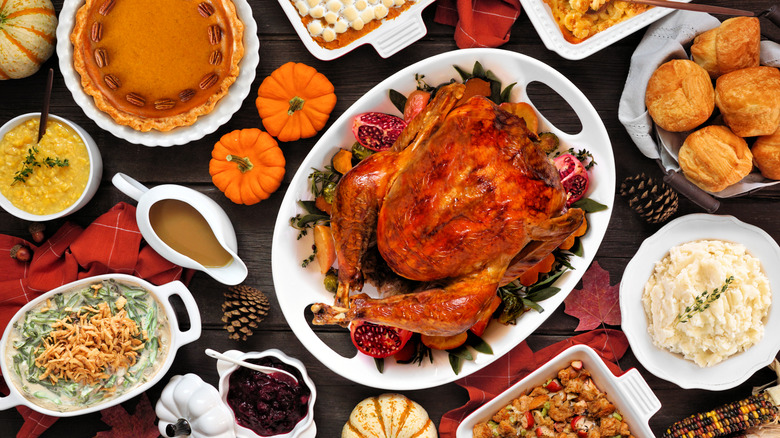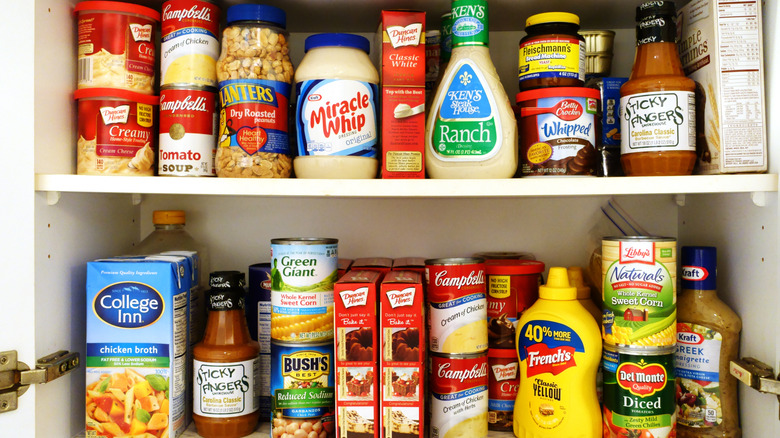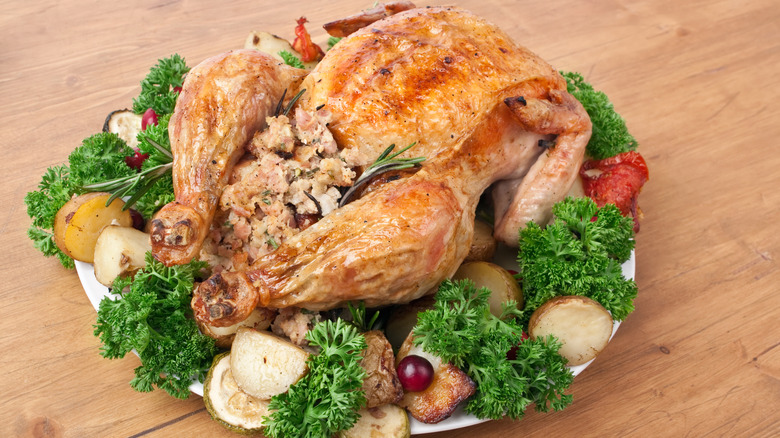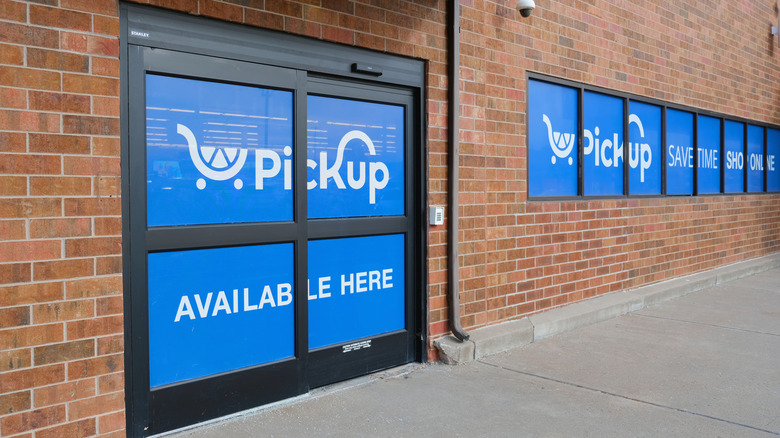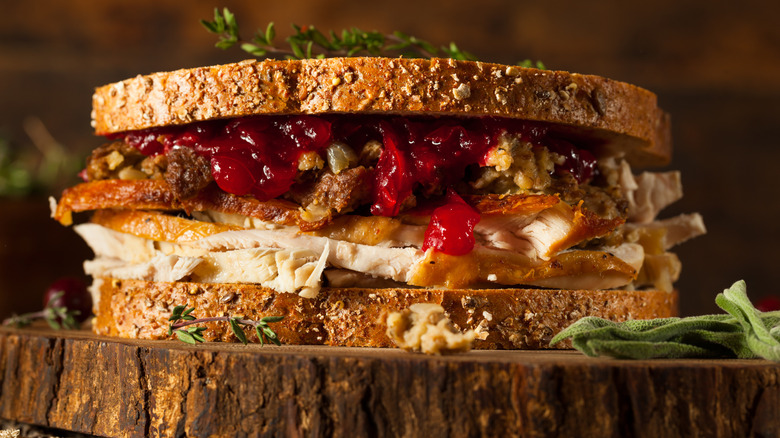11 Ways To Avoid Overspending This Thanksgiving
Americans have celebrated Thanksgiving since the Pilgrims and Wampanoag Native Americans shared a feast at Plymouth Rock in 1621. That gathering looked much different than today's celebrations. There isn't evidence turkey was served, but there was venison and an assortment of New England seafood. These days, the majority of Americans prefer a golden roasted bird, surrounded by a variety of classic sides such as warm rolls, mashed potatoes, and cranberry sauce. Creating the extravagant feast comes with a price tag, and establishing a financial strategy is essential to avoid overspending during the holiday.
Whether you are hosting a dinner, taking a side to Friendsgiving, or curating a fast food Thanksgiving meal, extra expenses can pile up and strain grocery budgets. From common-sense planning to understanding the psychological influences of the grocery store, this guide provides a strategy to navigate the tricky financial path ahead. We can't help with the annual blowup when Uncle Charlie decides to serve a slice of politics with his pumpkin pie, but we can help with tips for avoiding unexpected costs.
1. Create a realistic budget
Credit.org, a nonprofit financial wellness organization, says one of the biggest mistakes people make is not having a clear plan. Without a concrete plan, it's nearly impossible to avoid careening into the danger zone of impulse buys and overshopping. Setting clearly defined limits provides a framework for the rest of your holiday planning strategy. At the risk of sounding cliché, fail to plan, plan to fail. Save future-you money and stress by investing effort into budgeting.
Be realistic. It's a plan, not a wishing well. "Throwing numbers on paper doesn't mean anything if you can't actually obtain them," one Redditor advised on a budgeting thread. A good grocery budget is realistic about both what can be spent and the typical price of the ingredients needed. Many stores offer specials and coupons. Take advantage of these deals to lower costs and shift the savings to another area of the budget, or take them and come in under-budget.
The budget also needs to be complete. Listing everything helps visualize if a spending category is missing and prevents budget-busting surprises. Food is an obvious expense, but don't overlook associated costs like paper products, foil pans, and decorations. Once they are written down, the expenses are less overwhelming and it is easier to make clear-headed decisions on which can be adjusted or eliminated.
2. Make a detailed meal plan
Whether you are hosting a dinner party or contributing a side to a potluck, it is important to have a game plan. After making a budget, create a detailed meal plan that fits within that framework. Regularly compare the shopping list to the budget to confirm that it looks reasonable. Now is the time to re-strategize and adjust where needed. An accurate projection of expected costs makes it easier to identify areas of savings and avoid unwelcome surprises. If the initial recipe(s) don't reasonably fit within the budget, replace them or scale the plans back. It's easy to get carried away with the initial ideas and choose recipes with exotic (aka expensive) ingredients, or include extra sides that aren't needed.
Venturing into a grocery store without a clear plan of purchases is an invitation to fall victim to the psychological influences of the store and spend more than intended. "If you go without a list, you may as well just throw your money away," Leo Babauta provides as his number one shopping tip on Zen Habits. Like the budget, the shopping list needs to be complete. It should include the quantity of items needed, especially if recipes are being scaled for a crowd. If cooking pans or serving platters are needed, those items also need to be accounted for. Not only does this avoid surprise costs, it also makes execution of the meal less stressful by avoiding a last minute scramble for supplies.
3. Use classic, affordable ingredients
A good strategy for keeping the meal plan within your budget is relying on recipes that include affordable ingredients. Fortunately, many classic Thanksgiving dishes are made from seasonal produce that is typically some of the lower-priced items in the store. Mashed potatoes, green bean casserole, cornbread, and roasted squash are excellent Thanksgiving sides that are also budget friendly.
Resist the urge to overcomplicate the recipe or feel compelled to "elevate" it. While there are all sorts of embellishments that can be added to Thanksgiving sides, the extra expense doesn't necessarily result in a more enjoyable dish. "At Friendsgiving someone always tries to make it fancy," a Redditor wrote about green bean casserole, "like adding soggy chunks of bacon. It's not bad, it's just not good." Simple recipes can be just as, or more, satisfying than complicated ones. There is no need to break your budget with unnecessary add-ins.
Another way to keep prices in check is to use generic ingredients instead of name brand ones. Store brands are often indistinguishable from their name-brand cousins, but are sold at a fraction of the price. In some cases, the store brand is even made by the company who produces the more expensive product on the shelf next to it. (In these instances, producers provide the generic product in exchange for shelf space for their own products.) Avoid paying the name-brand premium and stock up on store brand items to substantially reduce the grocery bill.
4. Check your pantry
Creating a shopping list for a traditional Thanksgiving spread can be overwhelmingly long. Before putting the meal plan together, take stock of what is already in your pantry. It's possible there are forgotten items lurking on the back of the shelf, and incorporating them can reduce the number of groceries you need to buy. Instead of finding recipes and then searching the pantry for ingredients, start with what you have. Take everything out of the pantry and search for recipes that include those items. This subtle shift in mentality is not only cost-efficient, but it's also an opportunity to discover interesting recipes and techniques.
It's okay if the dishes aren't traditional holiday fare. The ones you discover may become favorites that are a unique family tradition. In other cases, there might be ingredients that add a spin to the classics and eliminate extra buys, such as a green bean casserole with a deliciously crunchy Funyun topping. Or reach for the half-full bottle of apple cider vinegar to make the sumptuously sweet corn salad Ina Garten swears by. Prioritizing using ingredients you already own keeps the shopping list manageable and prices down.
5. Organize a potluck
Thanksgiving is steeped in a tradition of sharing, and there is not an obligation for the host to cook all the food and foot the entire grocery bill. Remember, the Native Americans and Pilgrims both contributed to the first Thanksgiving. Many guests are excited to bring a dish. It gives them an opportunity to share a family recipe and ensure one of their holiday favorites is on the table.
However, a successful potluck requires organization. Create a sign up list so that you know what everyone is bringing and don't end up with multiple duplicates of the same dish. Include options for guests to volunteer to bring paper products, drinks, ice, decorations, or other items that let non-cooks contribute to the day. Spreading the responsibility allows everyone to be involved and keeps the cost reasonable for all.
If hosting the meal, don't hesitate to announce that it is BYOB. Providing wine and beverages for a group can be an astronomical expense. If you do want to provide an alcoholic beverage, consider sangria instead of wine for an affordable swap. Not only does sangria taste great when made with an inexpensive wine, it also stretches the bottle into more servings. Adding a handful of cranberries or apples gives the drink a fall theme that is perfect for the occasion.
6. Focus on quality over quantity
Americans eat more food on Thanksgiving Day than any other day in the year, including second-place Super Bowl Sunday. But amidst all the feasting, there is also an excessive amount of waste. A study by ReFED estimates that $550 million worth of food will be thrown out after Turkey Day 2025. That's money that is literally being thrown away.
Leftovers are great, but there is no benefit in buying food that will end up in the trash. Instead of trying to create the largest buffet in America, focus on serving the right amount of food and having a plan for leftovers. Unless you're serving a crowd, there is no need to roast a 30 pound turkey. For smaller groups, consider roasting a breast or thighs instead of a full bird. A roasted chicken is an option to provide the same visual aesthetic in a smaller portion.
A couple of well-made sides are more than enough for a satisfying meal, and it is usually cheaper to make them yourself instead of buying pre-made ones. Using recipes that consist of fresh fall produce is a good strategy for keeping prices lower and delivering a delicious meal. Not only are seasonal vegetables reasonably priced, they are also delicious without expensive add-ons. Roasted Brussels sprouts or squash with a drizzle of oil and a sprinkle of salt and pepper make an excellent side for the holiday meal.
7. Don't be obsessed with perfection
Thanksgiving is a uniquely American holiday and has a history this intertwined with some of its most revered leaders. While the 1621 feast in Plymouth Rock is considered the origin, the holiday wasn't officially recognized until 1789 when George Washington issued a proclamation calling for a national day of thanks to commemorate the end of the Revolutionary War. The permanent establishment of the holiday came much later, in 1863, when Abraham Lincoln declared it a national holiday.
It is intended to be an opportunity to gather with friends and family to express gratitude. That's more important than the food on the table or the decorations in the house. People will remember time together, but will forget if the turkey was dry or the napkins were cloth. Don't feel compelled to set a table that looks like Martha Stewart's staged photoshoot, and don't let perfection drive you to buy more than you can afford.
Set realistic expectations for the day and think about what truly matters. Then, focus on those things and let go of everything else. Financially speaking, that might mean eliminating or reducing the parts of the budget that don't directly support what matters most to you. "When you let go of the pressure to create a picture-perfect day and make space for realistic expectations, you open yourself up to appreciating the holiday for what it is," Calm recommends in its guide for thriving during the holidays.
8. Understand the psychology of the store
There is a reason that most shoppers arrive at the checkout with extra items in their grocery carts and only a vague understanding of how they got there. Every element of the store, from the type of music playing in the background to the layout of the products, is designed to influence shoppers' behaviors and encourage impulse buys. Being aware of the psychological factors at play helps the informed shopper resist temptations and unplanned purchases. Stores set the mood immediately, with a decompression zone that eases customers into a shopping mindset and avoids bombarding them with products immediately.
Once inside, grocery stores want to lure customers into the aisles and away from the lower-priced perimeter items. To do this, they utilize a racetrack layout that forces shoppers to weave through the aisles, and past as many products as possible. The geniuses behind the strategy know that Goldfish Butterbeer Flavored Grahams aren't on your shopping list, but might end up in your cart if you walk past them. Tempting items, that often have higher markups, are placed at eye level where they are prominently visible. The best defense is to diligently stick to the shopping list and resist the tempting impulse buys.
Stores choose the soundtrack carefully. Higher tempo music encourages quicker shopping, ideal for a location that thrives on high turnover. A slower tempo results in slower shopping, where customers spend more time browsing the aisles and are more likely to discover additional products.
9. Utilize curbside pick-up
One strategy to outsmart the layout wizards is to avoid setting foot in the store. Many major retailers offer online shopping options that allow you to order groceries and pick them up at the store. This has many advantages for the budget-conscious shopper. Primarily, it's easier to avoid temptation and stick to your plan while shopping online. Additionally, the running tab allows you to monitor what you are spending and avoid an unwelcome shock at checkout. It's also easier to remove items from a digital cart than it is to return a physical item to its place on the shelf.
Many shoppers swear that online shopping is the key to maintaining their budget, but there are still potential issues to be aware of. Some retailers charge a service fee for orders below a minimum amount, so read the fine print before filling an online cart. If you are using a third-party app instead of ordering directly from the store, there will almost certainly be a charge. Also, many skilled cooks will warn that a busy store employee isn't going to take the time to select the best produce. A potential strategy is to use online shopping to keep you from venturing into the aisles, but select the fresh vegetables and meats yourself.
10. Don't do all your shopping in one store
Another tactic stores use to bring shoppers in during the holidays is promoting eye-catching specials, but they aren't always what they are cooked up to be. Some seasonal items are marked up during the time of year they are not top sellers. Then, the price is reduced dramatically during the busy season to make the deal appear better than it actually is. To find the best deals, don't just look at how much the price is reduced, but instead compare the total price across multiple retailers.
That said, many stores offer great deals during the holidays and taking advantage of specials and coupons is a great way to keep prices down. However, a store might offer a great deal on a particular item, such as turkey, to bring customers into the store. At the same time, they might introduce a slight markup on other seasonal mainstays, banking on customers filling their carts with those items while they are in the store. Taking full advantage of the deals requires research into what the prices are at different retailers and visiting multiple locations to take advantage of the best ones at each location.
11. Have a plan for leftovers
Leftovers are arguably the second biggest joy of Thanksgiving and only trail spending quality time with friends and family. But, we've already mentioned the gross amount of food that is wasted each year. Planning ahead ensures you can flex your holiday budget by incorporating leftovers into meals in the following days. Don't throw away that opportunity.
Have a plan for how you are going to store leftovers, and put the food away before you collapse on the couch in a turkey induced coma to watch football. Most Thanksgiving foods can only remain at room temperature for two hours before they need to be thrown out. The timer is counting as soon as the table is set. Have storage containers or plastic bags ready to go, and put the food away as soon as you are done eating so it can safely be enjoyed later.
Have ideas for how you want to reuse the food. The Thanksgiving leftover sandwich is a classic standby, but there are other creative ways to use the food. Mashed potatoes can easily be turned into potato cakes for a satisfying Black Friday breakfast. Turkey bones and leftover veggies boil into a delicious stock for soup. Explore blogs and cookbooks for ideas on how to use every last bit of food.
